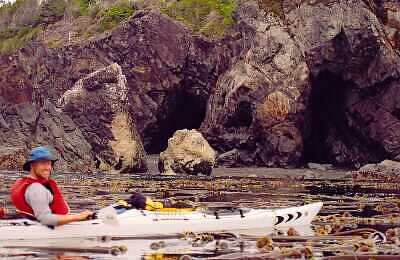
![[Eric exploring cave]](Photos/Eric_in_cave.jpg)
 |
![[Eric exploring cave]](Photos/Eric_in_cave.jpg)
|
On the water at 8 am this morning en route to Nootka Sound. We landed to explore a huge cave along the way, and two hours later rounded Maquinna Point into Nootka. We paddled up to Friendly Cove, after negotiating Yuquot Point, hung out our still wet clothes from our previous days washing at Calvin Creek, and enjoyed the sun and some food before heading up to explore the area.
Captain James Cook, commander of the ships Resolution and Discovery, first set foot here on March 29, 1778. Believing the area to be officially Spanish, based on the voyage of Juan Perez in 1774, Cook did not bother to claim it for the British Empire. Instead, while repairing his ships he explored the area and traded European goods for sea otter furs. Many of these furs were later sold for outrageous prices in China, and the trans-Pacific trade between Nootka and China began.
Al and I explored the area, hiked up to the lighthouse, and spoke with several Native Americans who were attending an annual gathering. If we had arrived a day earlier, we could have taken part in the festivities which consisted of Native American dancing, historical speeches from Mowachaht elders, and a traditional salmon dinner.
We left Friendly Cove, around 1pm, and crossed Nootka Sound to the Hesquiat Peninsula, landing near Escalante Point. Wow! What a beautiful spot! I paddled up the Escalante River to filter water, and felt like I had entered a jungle; huge mossy rocks, crystal clear water, giant ferns, and complete silence. I returned to our site with 16 liters of fresh water, set up camp, then sat comfortably in the sun to rest, read and relax.
![[Friendly Cove]](Photos/Friendly_Cove.jpg) |
Al and I took a long southerly hike down the Hesquiat Peninsula and discovered large wolf tracks and hundreds of sand dollars. On our way back to camp we came upon a well marked trail through the woods which eventually led back to our beach. Later we enjoyed a gorgeous sunset!
This was our shortest day of paddling yet, only 12 miles, but hope tomorrow that we'll make it all the way to Hot Springs Cove, just north west of Flores Island; what a pleasure it will be to soothe our muscles in the natural hot springs!
|
Yuquot History The internationally historic site of Yuquot - where the wind blows in all directions - was the summer home of Chief Maquinna and the Mowachaht/Muchalaht people for generations, housing approximately 1,500 natives in 20 traditional wooden longhouses. First Nations people came to magnificent Yuquot over 4,000 years ago, drawn by the rich sea life and natural resources, the mild climate, and the beautiful surroundings. Those same qualities still draw visitors to this magical place today, as there is so much to see and experience. In March 1778, Captain James Cook of the Royal Navy became the first European to set foot on British Columbian soil when he visited Friendly Cove on Nootka Island. While anchoring in Resolution Cove on Bligh Island, across from Friendly Cove, the natives hollered "itchme nutka, itchme nutka", meaning "go around" (to Yuqout), but Cook misinterpreted their calls, believing the name of the area to be Nootka. A Spanish trading post, Santa Cruz de Nutka, and Fort San Miguel, the only Spanish fort ever established in Canada, was maintained here between 1789 and 1795, with Nootka becoming an important focal point for English, Spanish and American traders and explorers The Nootka Convention was held in nearby Tahsis in 1792 to resolve the dispute between Spain and Britain over trading rights with the people of Yuquot. The talks between Captain George Vancouver and Captain Juan Francisco de la Quadra were facilitated by Chief Maquinna. The Canadian government declared Friendly Cove a National Historic Site in 1923, with recognition of the significance of the First Nations history following in 1997. On March 22 1803, while anchored in Nootka Sound, the trading vessel Boston was attacked by Nootka indians. Twenty-five of her twenty-seven crewmen were massacred, their heads "arranged in a line" for survivor John R. Jewitt to identify. Jewitt and the other survivor, John Thompson, became two of some fifty slaves owned by Chief Maquinna. The fascinating book White Slaves of Maquinna is John Jewitt's narrative of his capture and confinement at Nootka (1815). Today, members of the Mowachaht-Muchalaht First Nations conduct history tours that include a visit to the traditional gathering places of the Mowachaht-Muchalaht, the site of San Miguel, and opportunities to see spectacular old-growth forest, whales, otters, and other marine life. Visitors also have an opportunity to meet some of the friendliest, most hospitable people anywhere! Few tourist destinations in the world can offer the amazing cultural, historical and natural experience that awaits visitors to Yuquot. |
| Main Page | Next Day |
![[Escalante Creek]](Photos/Camp_at_Escelante_Creek.jpg)
|
![[Sunset at Escalante camp]](Photos/Escelante_sunset.jpg)
|